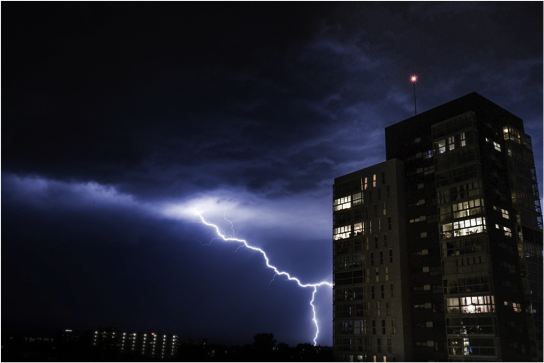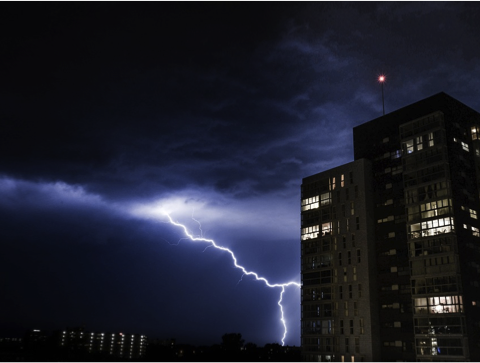 Globally, there are approximately 40 to 50 flashes of lightning every second, or nearly one and a half billion annually. Not only is the amount of strikes alarming, but each strike can have between 100 million and 1 billion volts and consumes billions of watts.
Globally, there are approximately 40 to 50 flashes of lightning every second, or nearly one and a half billion annually. Not only is the amount of strikes alarming, but each strike can have between 100 million and 1 billion volts and consumes billions of watts.
Such voltage and frequency cause irreparable personal injury and property damage, as well as unexpected equipment downtime, costly replacements and breaks in the production schedule. Lightning strikes may never be part of the schedule, but creating a defense for your facility with a lightning protection system should be.
In this post, we provide a brief overview of who needs a lightning protection system and the steps required to reduce the risk posed by lightning.
Who Needs a Lightning Protection System?
There is no known method of preventing the occurrence of a lightning discharge. The purpose of a lightning protection system, therefore, is to control the passage of a discharge in such a manner that prevents personal injury or property damage.
For architects, designers, developers and engineers, the need to provide protection should be assessed in the early stages of the structure design. Although no strict rules can be given, it is possible to use broad guidelines to arrive at the degree of protection required.
The general factors to consider include the level of risk lightning poses to personnel, equipment, structural damage and the consequential problems of a lightning-produced failure. Although not a strict science, assessment of these factors is one of judgment in comparing risks, economics and aesthetics. The ERICO Lightning Protection Solutions Guide provides questions to help you determine the level of protection suited for your structure.
What Are the Components of a Lightning Protection System?
The first mention of a traditional lighting rod—during the infancy stage of lightning protection systems—was published by Benjamin Franklin in 1750 in Gentleman’s Magazine. A year later he recommended the use of lightning rods to protect houses and other structures from lightning.
Although it varies on a case-by-case basis, Franklin’s recognition that the highest point of a facility is the most vulnerable to a direct lightning strike still forms the basis for many protection systems today.
However, fast-forward 250 years to see that the advanced lightning protection systems of today claim 84% to 99% effectiveness, based on the desired level of protection.
Below, we outline the basic steps and the corresponding components required to successfully prevent damage caused by lightning strikes.
1. Intercept the Lightning Flash
As Franklin noted, the highest point of a facility is the most vulnerable to a direct lightning strike. Lightning rods or air terminals capture the strike at a preferred point, and help to conduct the energy to the ground to minimize the risk of damage.
The two keys to effective strike termination devices (i.e. lightning rods or air terminals) are the type and placement.
Types of air terminal can be one of the following, depending on the application:
- Rods — typically copper or aluminum
- Masts — can be copper, aluminum, fiberglass, or stainless steel
- Meshed conductors (on building surface or elevated)
- Catenary wires
- Natural components
To best capture lightning strikes, the following considerations should be made for air terminal placement, often dependent on material type:
- Install as close as practical to roof edges.
- Secure per requirements.
- Select materials to reduce risk of corrosion.
- Do not introduce trip hazards upon roof surface.
- Do not locate in areas where water may pool (e.g. gutters).
- Avoid penetrations into roof for fixing of conductors.
For more information on air-termination specification requirements and suggestions, see the ERICO Lightning Protection Handbook.
2. Conduct the Lightning Current to Earth
The components required to do this are known as down conductors, which provide the interconnection of the air terminations to the earth-termination system. They generally follow the profile of the structure, without being positioned where safety to individuals could be compromised.
Down conductors should provide multiple parallel paths for the discharge of energy from the lightning to the ground. Doing so lowers the risk of current density, thus reducing the risk of side flashing. This also reduces electromagnetic radiation effects of the impulse current at points inside the structure.
In general, a down conductor system should:
- Provide multiple paths for lightning current.
- Be as short and straight as practical.
- Be spaced and use equipotential bonding rings.
- Be a direct continuation of the air-termination system.
- Not be installed in gutters or down spouts (even if PVC covered).
- Connect via a test joint to the earth termination network.
- Be fitted with external protection to reduce exposure to accidental damage or vandalism.
- Be fitted with three-millimeter, cross-linked polyethylene insulation where there is risk of danger due to touch potential.
Detailed requirements exist for type, spacing and more for various buildings, which can be found in the ERICO Lightning Protection Handbook.
3. Dissipate Current into the Earth
The reliable performance of the entire lightning protection system is dependent upon an effective earthing or grounding system.
Consideration for earthing systems must be given to:
- Providing a low impedance network to dissipate the fast-rising lightning impulse.
- Minimizing potential of touch and step hazards.
- Long-term performance of the system – i.e. quality of materials and connections.
Grounding systems can be comprised of:
- Ground rods
- Perimeter (ring) bare wire
- Radials
- Ground plates
- Concrete (rebar)
4. Create an Equipotential Bond
Equipotential bonding is required to eliminate voltage gradients, which reduces the possibility of electric shock or electrical equipment fault.
Each product, from the air termination system to the conductors to the grounding system, must work in tandem to effectively transfer discharge from interception to dissipation—without posing risks to people or the building.
In achieving overall effectiveness, the lightning protection system must:
- Reduce thermal or mechanical damage to the structure.
- Avoid sparking, which may cause fire or explosion.
- Limit step and touch voltages to control the risk of injury to occupants.
- Avoid damage to internal electrical and electronic systems.
Want to Learn More About Lightning and Lightning Protection Systems?
Download our guide on lightning protection to learn about the fundamentals of a lightning strike. See if your building is on the list of structures particularly at risk of strikes and learn about the specific components available to effectively intercept, conduct and ground a lightning strike. Equip yourself with the knowledge to fully prepare your facility in the event of a lightning storm.
Image credit: Pixabay

